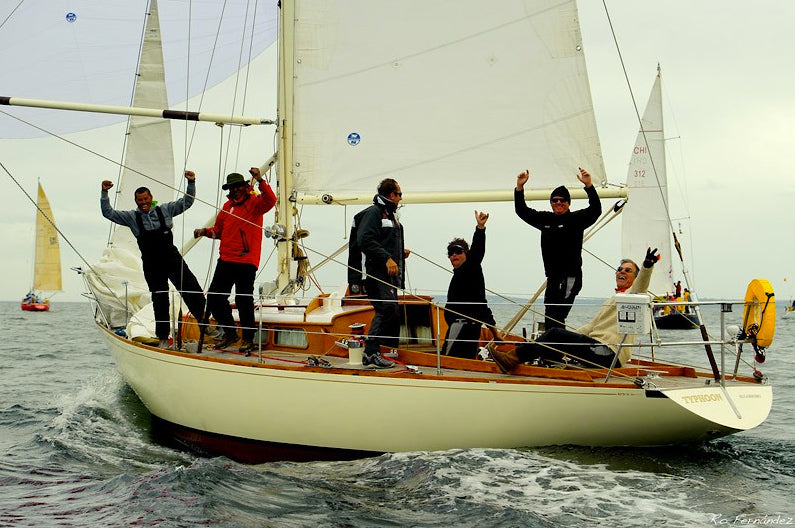ORGANIZE YOUR CREW
If you want to drive the boat, trim the sails, watch the instruments, read the compass, track the fleet, and call tactics—then race singlehanded. If you want to race with a crew, a careful division of responsibilities is the only way to succeed against other well-balanced teams.
There are three basic building blocks of a successful race pyramid: boathandling, boat speed, and tactics. Your crew must be organized so each block gets the attention required. A crew boss is needed to orchestrate boat handling. Sail trimmers and a driver are needed to focus on boat speed, and a tactician is needed to manage the course.
As soon as you have more than one person on the boat it is time to divide up the chores. On championship two-person boats, the driver drives and the crew does tactics. On a three-person crew, the forward crew and driver focus on trim, while the middle crew handles tactics.
Crew assignments should be based on the number, skill, experience, and interest of your crew. Each crew position should have clearly defined responsibilities during each maneuver, and maneuvers should be executed the same way each time.
Principles of Crew Assignments
Divide and Conquer
During each boathandling maneuver, divide the crew into two teams: one to sail fast with the sails you’ve got, the other to get sails up and down. No one should serve on both teams.
Define Crew Positions
Each crew position has a specific responsibility during each evolution or maneuver. First, figure out the correct number of crew, define each position, and then sail with a full complement of crew every time you race. Once positions are defined, you can plug new people into a specific position that has clearly defined responsibilities. Writing out and diagramming your standard maneuvers will help during routine maneuvers, and also during the inevitable ad lib.
Create Crew Pairs
Ideally, you would have the same people in the same position for every race (yea, right—if pigs could fly). Since you can’t expect that, work toward a nucleus you can count on, and then pair new (or less experienced) crew with a regular crew member. For example, a new mast crew can be paired with an experienced foredeck, or an experienced trimmer can watch over a new grinder.
Do Your Job
If one person is having trouble completing a task, that can create a problem. When the next person tries to help out, and leaves part of her job undone, the problem grows. Pretty soon the entire crew is out of place—each trying to help another—and you have a huge mess. Unless it’s a flat-out emergency, stick to doing your assigned job.
Practice
The key to developing good crew work is practice. It is simply impossible to train crew during a race. There is not enough time to teach and learn, and there is too much to do. You must practice to win. There is no other way.
Practice Drills
As you plan your maneuvers, keep the Divide and Conquer principle in mind. Always keep part of the crew focused on going fast, even when the rest are attending to a boat handling maneuver. Try a simple walk through on the dock, or at least with no sails, to figure out the rough details and positioning.
Once on the water, go through maneuvers one at a time: tacks, jibes, sets, douses, reefs, sail changes, plus straight line trim and speed. Detail each person’s responsibility during each maneuver. Once you can run through each evolution smoothly in open water, try it around a closed course of buoys to add the element of timing.
Another excellent drill is to perform maneuvers in total silence. A single word from the helmsman (or crew boss) is all that is needed to initiate the maneuver. In silence you learn to watch and work with your crew mates. Learning to work quietly keeps the airwaves open for the unexpected.
Another effective practice tool is rotating crew positions. If the pit and foredeck, for example, switch places, each will understand better what is going on and can anticipate the other’s needs during a race. Similarly, trimmers and drivers who trade places will better understand how they impact each other.
Find a Tuning Partner
Once your crew work is smooth, find another boat to practice with. Sail parallel courses to work on boat speed. Use cat-and-mouse drills to improve boat handling. Try short match races to add competitive fervor. When you are confident of your boat handling and speed, then you are ready to race.
The difficulty of boat handling increases with the wind, so keep practicing until you are confident in all conditions. Try to refine your techniques to reduce crew movement. Pay attention to weight placement all the time. Figure out ways to keep weight properly placed as much as possible.
Your crew organization and crew assignments are dictated, in part, by your boat’s layout. If you find one crew member is overburdened during a particular maneuver, look into reorganizing the crew—and perhaps changing your layout, to redistribute the load.



























